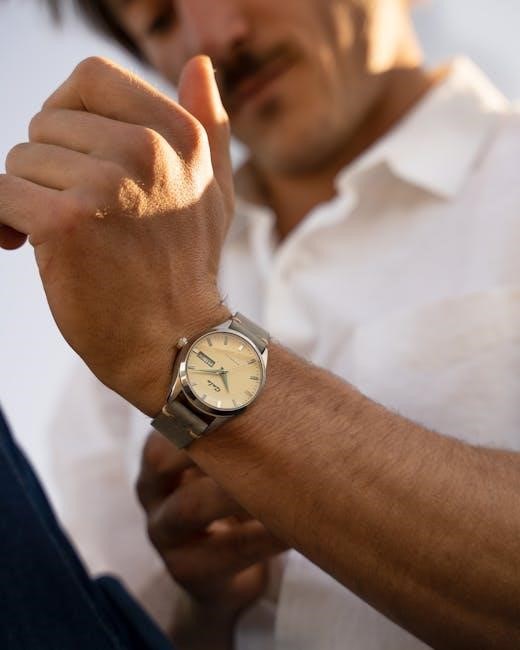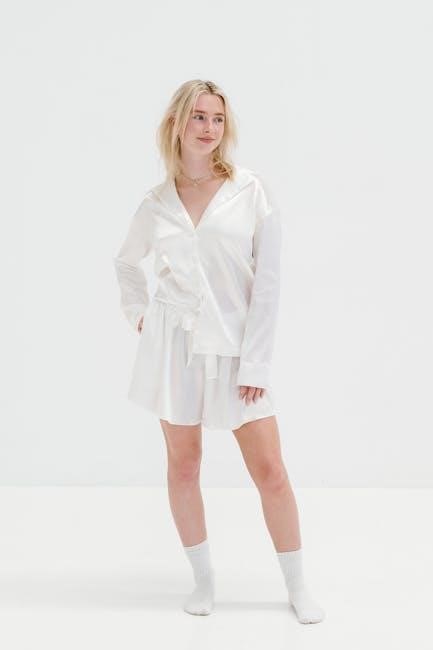Understanding Australian men’s shirt sizing is essential for a perfect fit. Sizes vary by brand, with measurements based on neck, chest, and sleeve length. Always refer to size charts for accuracy, as Australian sizes differ from international standards. Proper fitting ensures comfort and style, whether for casual or formal wear.
Understanding the Basics of Shirt Sizing in Australia
Australian men’s shirt sizing is primarily based on measurements of the neck, chest, and sleeve length. These measurements determine the fit and comfort of the shirt. The sizing system varies slightly between brands, with some using numerical sizes and others using alphabetical labels like XS, S, M, L, and XL. Understanding these measurements is crucial for selecting the right size. Key measurements include the neck circumference, chest width, and sleeve length. Additionally, fit styles such as Slim Fit, Casual Fit, or No Tuck Slim Fit can affect how the shirt drapes on the body. Always refer to the specific brand’s size chart, as sizing can differ. Accurate measurements ensure a tailored fit, whether for formal or casual wear. Proper sizing enhances both comfort and style, making it essential to take the time to measure correctly.

Measurement Basics for Men’s Shirts
Key measurements for men’s shirts include neck circumference, chest width, sleeve length, and waist. Accurate measurements ensure a proper fit, so compare with a well-fitting shirt for precision.
How to Measure Your Neck for Shirt Size
To measure your neck for shirt size, use a flexible tape measure or a piece of string. Place the tape measure around the base of your neck, ensuring it is snug but not too tight or loose. The tape should be level and parallel to the floor, typically just above the collarbone. If using a string, mark where the ends meet and measure against a ruler. The measurement should be taken directly on the skin for accuracy. Compare your measurement to the shirt size chart, considering any personal preference for a looser fit. If your measurement falls between sizes, round up for comfort. Ensure the tape measure is clean and consider having someone assist for precise results.
How to Measure Your Chest for Shirt Size
To measure your chest for shirt size, wrap a flexible tape measure around the fullest part of your chest, keeping the tape parallel to the ground. Ensure the tape is snug but not too tight and passes under your armpits, crossing the shoulder blades at the back. If using a string, mark the point where it overlaps and measure it against a ruler. For the most accurate reading, stand up straight and take the measurement while wearing a thin shirt. Double the measurement to get the full chest circumference, which corresponds to your shirt size. If your measurement falls between sizes, consider rounding up for a comfortable fit. Always refer to the specific brand’s size chart, as chest measurements can vary slightly between Australian brands and international standards.
How to Measure Sleeve Length for Shirts
To measure sleeve length accurately, start by standing straight with your arms slightly bent. Place the tape measure at the center back of your neck, just below the base of the collar. Gently extend the tape down over your shoulder, following the natural curve of your arm, and end at the edge of your wrist bone. Ensure the tape is snug but not too tight, and avoid pulling it taut. This measurement gives the total sleeve length. For a more precise fit, some brands may require measuring from the shoulder seam to the wrist, ensuring the shirt cuff aligns with your wrist bone. Always refer to the specific size chart of the brand you’re purchasing from, as sleeve lengths can vary slightly between Australian brands. Accurate measurements help ensure a comfortable and tailored fit.
How to Measure Waist for Shirts
To accurately measure your waist for shirt sizing, start by identifying the narrowest part of your torso, typically just above your hipbone and below your ribcage. Stand upright and relax your stomach muscles. Wrap a flexible tape measure around this area, ensuring it is level and parallel to the floor. The tape should be snug but not overly tight or constricting. For the most precise measurement, keep the shirt buttoned and the tape measure positioned mid-way between the bottom of your ribcage and the top of your hipbone. Note the measurement in centimeters or inches. This measurement helps determine the waist fit of your shirt, ensuring it is neither too tight nor too loose. Always refer to the specific size chart of the brand you are purchasing from, as waist measurements may vary slightly between Australian brands.

Official Australian Men’s Shirt Size Chart
The official Australian men’s shirt size chart provides standard measurements for chest, waist, neck, and sleeve lengths. Sizes range from XS to 3XL, ensuring a precise fit for all body types.
Chest and Waist Measurements for Australian Shirt Sizes
Chest and waist measurements are crucial for determining shirt sizes in Australia. The chest size is measured around the fullest part of the chest, typically ranging from 86cm to 120cm across various sizes (XS to 3XL). Waist measurements, taken at the narrowest point, usually range from 72cm to 104cm. These measurements ensure a tailored fit, whether you prefer a slim or casual style. Proper alignment of these measurements with size charts helps in selecting the ideal shirt, avoiding the need for alterations. Australian brands often align their sizing closely with these standards, though slight variations may occur. Always refer to the specific brand’s size guide for the most accurate fit.
Neck and Sleeve Length Measurements for Australian Shirts
Neck and sleeve length measurements are key components in determining Australian shirt sizes. The neck measurement, taken around the base of the neck, typically ranges from 34cm to 46cm, corresponding to collar sizes. Sleeve length is measured from the center back of the neck, over the shoulder, and down to the cuff, generally ranging from 78cm to 88cm for standard fits. These measurements ensure the shirt drapes correctly and provides a comfortable fit. Variations may exist between brands, so consulting a size chart is essential. Accurate measurements help avoid sizing errors, ensuring the perfect balance of style and comfort in Australian men’s shirts.

Comparison of Australian and International Shirt Sizes
Australian shirt sizes differ from international standards, often using lettered sizing (XS-XXL) compared to US numerical measurements and European centimeter-based systems. Use conversion charts for accurate fitting.
Converting Australian Shirt Sizes to US Standards
Converting Australian shirt sizes to US standards requires understanding the differences in sizing systems. Australian shirts often use a lettered system (XS-XXL), while US sizes typically use numerical measurements based on chest circumference. For example, an Australian Medium (M) generally corresponds to a US Medium, but variations can occur between brands. To ensure accuracy, compare specific measurements like chest and sleeve length. Australian sizes may also align closely with US sizes when considering chest circumference, as both systems prioritize this measurement for fit. Always refer to official size charts or conversion guides to match your Australian size to the equivalent US size. Double-checking measurements ensures a seamless fit, especially when shopping internationally or across different brands. Using a reliable conversion tool or chart is recommended for the best results.
Converting Australian Shirt Sizes to European Standards
Converting Australian shirt sizes to European standards involves understanding the differences in sizing systems. Australian sizes often align closely with European sizes, but variations can occur due to differing measurement standards. For instance, an Australian Medium (M) generally corresponds to a European Medium, but chest and sleeve measurements may differ slightly. To convert accurately, compare specific measurements such as chest circumference, sleeve length, and neck size. European sizes tend to be slightly smaller in chest measurements compared to Australian sizes, so it’s essential to refer to official size charts or conversion tools. Additionally, fit styles like Slim Fit may vary between regions, so double-checking measurements is crucial for the best fit. Always consult a reliable size conversion guide to ensure accuracy when shopping across regions or brands.

Understanding Fit Styles for Men’s Shirts
Australian men’s shirts come in various fit styles, including Slim Fit, Casual Fit, and No Tuck Slim Fit. Each style offers a unique cut to suit different body types and preferences, ensuring a tailored look.
Slim Fit shirts
Slim Fit shirts are designed to provide a tailored, contemporary look, ideal for men seeking a modern silhouette. These shirts are cut closer to the body, with narrower sleeves and a shorter length compared to Casual Fit styles. They are perfect for slimmer builds or those wanting a sharper, more fashionable appearance. Slim Fit shirts often feature slightly smaller chest and shoulder measurements, ensuring a sleek, streamlined fit. They are versatile, suitable for both casual and semi-formal occasions. When choosing a Slim Fit shirt, consider your body type and personal style to ensure comfort and confidence. Proper measurements are key to selecting the right size, as Slim Fit shirts are designed to hug the body without being restrictive. This style is particularly popular among younger men and those who prefer a trendy, polished look. Always refer to the size chart for accurate sizing to ensure the best fit.
Casual Fit shirts
Casual Fit shirts offer a relaxed and comfortable silhouette, perfect for everyday wear. These shirts are designed with a looser cut, providing ease of movement and a classic, timeless look. Unlike Slim Fit styles, Casual Fit shirts have a roomier chest, shoulders, and sleeves, making them ideal for all body types. They are great for casual outings, outdoor activities, or layering under jackets. The relaxed fit ensures comfort without sacrificing style, making them a versatile choice for various occasions. When selecting a Casual Fit shirt, consider your lifestyle and personal preference for a looser fit. Always check the size chart to ensure the best fit, as measurements can vary slightly between brands. This style is popular for its comfort and versatility, appealing to a wide range of men seeking a laid-back yet stylish option.
No Tuck Slim Fit shirts
No Tuck Slim Fit shirts are designed for a modern, streamlined look while offering comfort and practicality. These shirts are tailored to be slightly shorter in length, making them ideal for casual, untucked wear. They feature a slim cut through the chest and sleeves, creating a sharp, contemporary silhouette without restricting movement. The shorter hemline ensures the shirt stays neatly in place when worn untucked, providing a polished yet relaxed appearance. This style is particularly recommended for men under 184 cm in height, as it proportionally balances their frame. No Tuck Slim Fit shirts are versatile, suitable for both casual and smart-casual settings, making them a popular choice for everyday wear. They are crafted to eliminate the need for tucking, offering a fashionable and practical solution for modern men seeking comfort and style.

Brand-Specific Sizing in Australia
Australian brands often have unique sizing standards, varying slightly from each other. Always check the specific size chart for your preferred brand to ensure the best fit and avoid discrepancies. Proper measurements and comparisons are key to selecting the right size, as differences in cuts and styles can affect fit. This approach ensures comfort and style, regardless of the brand chosen.
Popular Australian Brands and Their Sizing Differences
Popular Australian brands like Camixa and Nautica offer distinct sizing approaches. Camixa’s shirts align closely with standard Australian sizing, ensuring a consistent fit across their collections. Nautica, known for its classic designs, provides detailed size charts, including chest and waist measurements, to guide customers accurately. Some brands, such as Lonsdale, may offer a more tailored fit, while others like Gloweave combine numerical and alphabetic sizing for clarity. These variations mean that understanding each brand’s specific measurements is crucial for selecting the right size. Always refer to the brand’s size guide to ensure the best fit, as differences in cuts and styles can affect the overall comfort and appearance of the shirt. This attention to detail helps customers make informed purchasing decisions and enjoy a perfectly fitting garment.
How to Choose the Right Size for Your Favorite Brand

To select the perfect size for your preferred Australian brand, start by taking accurate body measurements. Measure your neck at the base, chest at the fullest point, and sleeve length from the neck to wrist. Compare these measurements to the brand’s size chart, as sizing can vary. For instance, Camixa offers standard Australian sizing, while Nautica provides detailed charts for precise fits. If unsure, refer to sizing guides or videos for clarity. Reading customer reviews can also offer insights into fit consistency. For additional assurance, contact the brand’s customer service for personalized advice. By meticulously following these steps, you can ensure a well-fitting shirt that meets your style and comfort expectations, making your purchasing experience seamless and satisfactory.

How to Use a Shirt Size Guide Effectively
Measure your chest, neck, and sleeve, compare with the chart, and choose your fit for a perfect, accurate fit, ensuring comfort and style.
Step-by-Step Guide to Finding Your Perfect Shirt Size

To find your ideal shirt size, start by gathering a flexible tape measure. Measure your neck circumference at the base, ensuring the tape is snug but not tight. Next, measure your chest around the fullest part, keeping the tape horizontal. For sleeve length, measure from the center back of your neck to your wrist with your arm slightly bent. If applicable, measure your waist to ensure the best fit. Compare these measurements to the Australian shirt size chart, noting numerical or alpha sizing (XS-5XL). Consider your preferred fit style—Slim Fit, Casual, or No Tuck—to refine your choice. Always check brand-specific sizing guides, as variations exist. For accuracy, don’t guess your size; use the chart or consult customer support if unsure. This method ensures a tailored fit for comfort and style.
Using Measurement Charts for Accurate Sizing
Measurement charts are indispensable for ensuring a precise fit when shopping for men’s shirts in Australia. Start by measuring your neck, chest, and sleeve length using a flexible tape measure. Compare these measurements to the official Australian shirt size chart, which typically includes numerical and alpha sizing (XS-5XL). Most charts provide measurements in centimeters and inches for convenience. Pay attention to the specific cut of the shirt, as Slim Fit, Casual, or No Tuck styles may require adjustments. To use the chart effectively, match your measurements to the closest size listed. If your measurements fall between sizes, consider the intended fit style. Always refer to brand-specific charts, as sizing can vary. Using measurement charts eliminates guesswork and ensures a shirt that fits perfectly, whether for casual or formal occasions.

Common Mistakes to Avoid When Buying Shirts
Guessing your size without measuring is a common error. Always check the size chart for accurate fitting. Assuming all brands size similarly can lead to poor fit.
Why You Shouldn’t Guess Your Size
Guessing your shirt size can lead to poor fit and discomfort. Australian brands often have varying sizing standards, making it crucial to measure accurately. Without proper measurements, shirts may be too tight or loose, affecting both appearance and comfort. Always refer to the specific size chart provided by the retailer to ensure the best fit. Ignoring measurements can result in returns or alterations, wasting time and money. Take a few minutes to measure your neck, chest, and sleeve length for a precise fit. This ensures your shirt looks great and feels comfortable, whether for casual or formal occasions.
The Importance of Checking Size Charts Before Purchasing
Checking size charts is vital for ensuring a perfect fit when purchasing shirts. Australian brands often have unique sizing standards that differ from international measurements. By comparing your measurements to the chart, you can avoid common issues like tight or loose fits. This step is especially important when shopping online, where you can’t try the shirt on beforehand. Ignoring size charts may lead to returns or alterations, which can be inconvenient and costly. Taking the time to review the chart ensures your shirt fits comfortably and looks great, enhancing your overall shopping experience. Always prioritize accuracy over assumptions to make informed purchasing decisions.
By understanding Australian shirt sizing, measuring accurately, and using size charts, you can confidently find your perfect fit, ensuring comfort and style in every purchase;
Final Tips for Finding the Perfect Fitting Shirt in Australia
To ensure the best fit, always measure yourself accurately and compare with size charts. Avoid guessing your size, as Australian brands often vary. Consider your body type and personal style when choosing between slim, casual, or no-tuck fits. Double-check the specific measurements for chest, neck, and sleeve length. If unsure, refer to brand-specific guides or contact customer support. Remember, some brands offer unique fits, so understanding their sizing differences is key. Lastly, don’t hesitate to seek help or watch sizing videos for guidance. By following these tips, you’ll confidently find a shirt that combines comfort and style perfectly.
